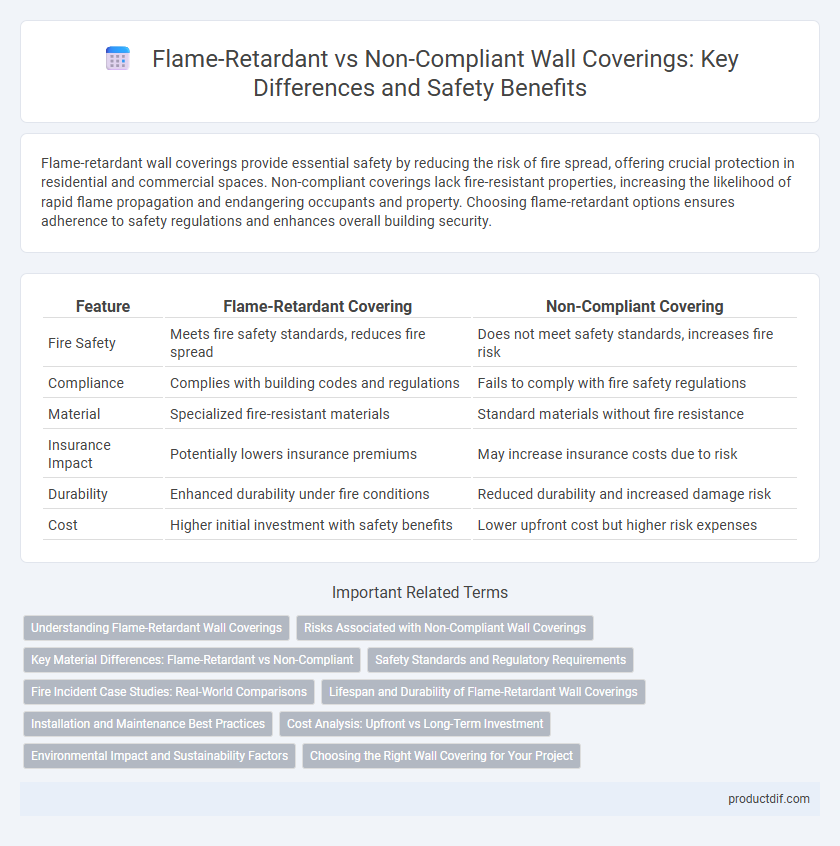Flame-retardant wall coverings provide essential safety by reducing the risk of fire spread, offering crucial protection in residential and commercial spaces. Non-compliant coverings lack fire-resistant properties, increasing the likelihood of rapid flame propagation and endangering occupants and property. Choosing flame-retardant options ensures adherence to safety regulations and enhances overall building security.
Table of Comparison
| Feature | Flame-Retardant Covering | Non-Compliant Covering |
|---|---|---|
| Fire Safety | Meets fire safety standards, reduces fire spread | Does not meet safety standards, increases fire risk |
| Compliance | Complies with building codes and regulations | Fails to comply with fire safety regulations |
| Material | Specialized fire-resistant materials | Standard materials without fire resistance |
| Insurance Impact | Potentially lowers insurance premiums | May increase insurance costs due to risk |
| Durability | Enhanced durability under fire conditions | Reduced durability and increased damage risk |
| Cost | Higher initial investment with safety benefits | Lower upfront cost but higher risk expenses |
Understanding Flame-Retardant Wall Coverings
Flame-retardant wall coverings are specially treated to resist ignition and slow the spread of fire, enhancing building safety and compliance with fire codes. These coverings utilize materials such as fiberglass, treated fabrics, or vinyl with fire-resistant coatings that meet standards like ASTM E84 or NFPA 701. Non-compliant wall coverings lack these protective properties, significantly increasing fire risk and failing to meet regulatory requirements.
Risks Associated with Non-Compliant Wall Coverings
Non-compliant wall coverings pose significant fire hazards due to their lack of flame-retardant properties, increasing the risk of rapid fire spread and toxic smoke emission. Building regulations strictly mandate flame-retardant coverings to enhance occupant safety and minimize fire-related damage. Ignoring these standards can result in property loss, legal liabilities, and compromised emergency response effectiveness.
Key Material Differences: Flame-Retardant vs Non-Compliant
Flame-retardant wall coverings are formulated with specialized chemical additives such as halogenated compounds, aluminum trihydrate, or phosphorus-based agents that inhibit ignition and slow flame propagation. Non-compliant coverings lack these fire-resistant materials, often using standard polymers and fibers that can readily ignite and contribute to rapid flame spread. The key material difference lies in the presence of flame-retardant additives in compliant coverings, which enhance safety by meeting fire safety regulations and reducing flammability hazards in interior spaces.
Safety Standards and Regulatory Requirements
Flame-retardant wall coverings are designed to meet stringent safety standards such as NFPA 701 and ASTM E84, significantly reducing fire hazards in commercial and residential buildings. Non-compliant coverings often lack certification and fail to adhere to regulatory requirements, increasing the risk of rapid fire spread and legal liabilities. Compliance with fire safety regulations ensures enhanced occupant protection and lowers insurance premiums.
Fire Incident Case Studies: Real-World Comparisons
Flame-retardant wall coverings significantly reduce the spread and intensity of fire, as demonstrated in multiple fire incident case studies where buildings with compliant materials experienced less structural damage and faster fire suppression. In contrast, non-compliant coverings contributed to rapid fire propagation, increased toxic smoke emission, and higher casualty rates in real-world fire scenarios. These comparisons highlight the critical importance of selecting flame-retardant materials to enhance occupant safety and minimize property loss during fire emergencies.
Lifespan and Durability of Flame-Retardant Wall Coverings
Flame-retardant wall coverings are engineered to resist ignition and slow the spread of fire, significantly extending their lifespan compared to non-compliant coverings that often degrade faster due to unsupportive material properties. These coverings utilize advanced materials such as fiberglass or treated vinyl, which enhance durability by resisting wear, moisture, and environmental damage, ensuring long-term performance in both residential and commercial spaces. The extended durability of flame-retardant coverings reduces maintenance and replacement costs, making them a safer and more cost-effective choice over their non-compliant counterparts.
Installation and Maintenance Best Practices
Flame-retardant wall coverings require precise installation techniques such as ensuring seamless adhesion and using fire-resistant adhesives to maintain their protective properties, while non-compliant coverings lack these strict requirements, posing fire safety risks. Regular maintenance of flame-retardant coverings involves routine inspections for damage and prompt repairs to preserve fire resistance, whereas non-compliant coverings may degrade faster and increase hazard likelihood. Compliance with fire safety codes during installation and maintenance ensures long-term durability and safety of flame-retardant wall coverings.
Cost Analysis: Upfront vs Long-Term Investment
Flame-retardant wall coverings typically incur higher upfront costs ranging from $2 to $5 per square foot compared to non-compliant coverings, which may cost under $1.50 per square foot. Long-term investment analysis reveals that flame-retardant options reduce fire-related insurance premiums and potential damage expenses, creating significant cost savings over time. Non-compliant coverings pose higher financial risks due to increased fire hazards, potentially leading to costly repairs and liability claims.
Environmental Impact and Sustainability Factors
Flame-retardant wall coverings significantly reduce the risk of fire-related hazards while minimizing the release of toxic emissions, promoting safer indoor air quality and environmental health. Non-compliant coverings often contain hazardous chemicals that contribute to pollution and pose long-term sustainability challenges due to their non-biodegradable nature and harmful disposal impact. Selecting flame-retardant materials supports sustainable building practices by enhancing fire safety without compromising ecological balance or increasing environmental footprint.
Choosing the Right Wall Covering for Your Project
Flame-retardant wall coverings are essential for meeting fire safety regulations and reducing the risk of fire spreading, making them ideal for commercial and high-occupancy spaces. Non-compliant coverings may save initial costs but can lead to legal issues, insurance challenges, and increased danger during emergencies. Selecting flame-retardant materials ensures compliance with safety standards like NFPA 701 and contributes to a safer, more secure environment for occupants.
Flame-Retardant Covering vs Non-Compliant Covering Infographic

 productdif.com
productdif.com